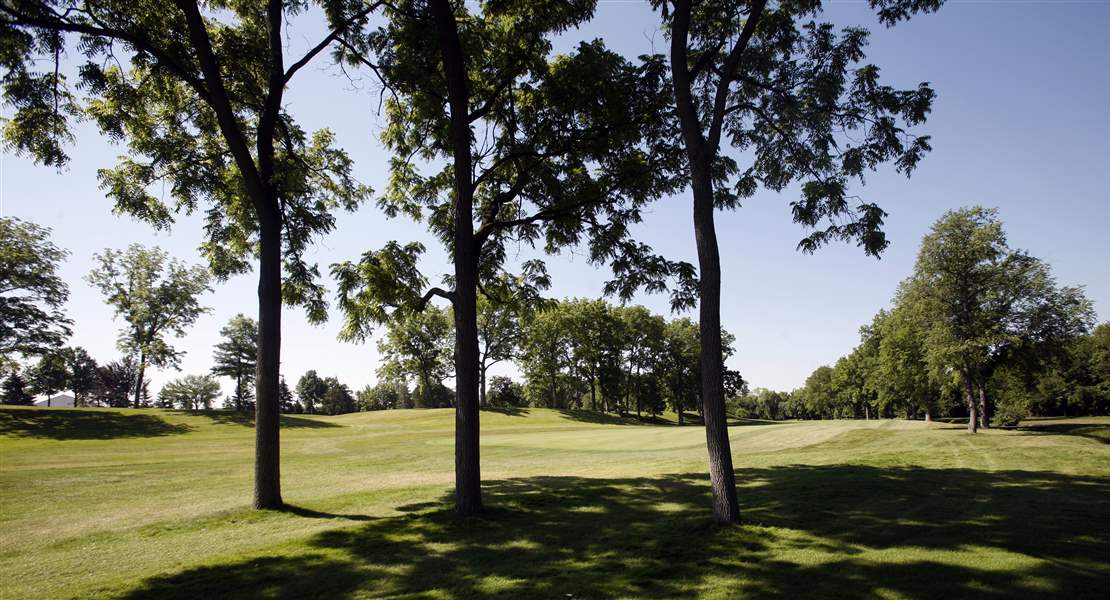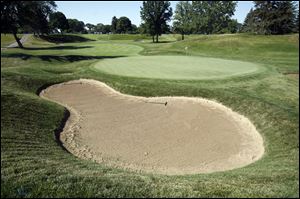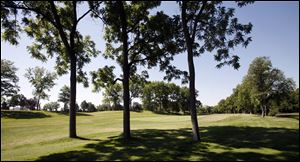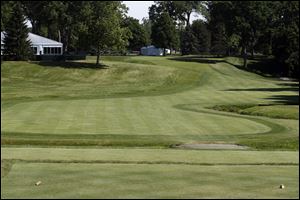
Inverness adjusts to accommodate more fans
5 holes from front, 5 from back are flipped
7/24/2011
A creek, a dogleg, and plenty of trees, including this cluster on the right edge of the fairway, give the 14th hole plenty of bite.
The Blade/Andy Morrison
Buy This Image

One of the course's prettiest second shots, from the elevated fairway at No. 6, got prettier when Inverness spruced up the bunker complex around the green, including this giant pit behind the putting surface.
It is no secret that Inverness Club long ago presented an invitation to the United States Golf Association to bring a U.S. Open back to the Toledo course for the first time since 1979.
One of the USGA's apparent concerns has been spectator flow, especially on the back nine. Consider this hypothetical: Tiger Woods and Phil Mickelson, tied for the lead, playing in the final two groups on Sunday afternoon, and some 45,000 fans crowded into a congested, mostly out-and-back routing of the back nine trying to witness the finish.
During and since the 2003 U.S. Senior Open at Inverness, USGA officials mentioned those concerns to local tournament staffers. During this week's return of the Senior Open to the Dorr Street course, Inverness will find out if it has the answer.
Five holes on the front nine and five from the back nine will be flip-flopped for this week's championship. Inverness holes 3-7 will become Nos. 12-16 for the Senior Open while Inverness holes 12-16 will become Nos. 3-7 during this week's play.
"We are trying to do everything possible to show the USGA that Inverness can host an Open from the standpoint of the infrastructure required, both inside and outside of the ropes," said Judd Silverman, an Inverness member and tournament director for the Senior Open. "This is an attempt to spread the course and accommodate more fans smoothly, especially on the back nine."

Whether it gets the USGA's attention is another story for another day. The next unassigned U.S. Open is in 2020, which coincidentally would be the 100th anniversary of the first Open held at Inverness.
Today's story, though, is the challenges the routing changes will present for the 156-player field in the Senior Open.
First of all, it's going to make for a back nine as difficult as any these players -- maybe any players on any tour in any major championship -- will face.
The two toughest par 4s on the course, normally Nos. 4 and 7, and the two most testy par-3 holes, normally Nos. 3 and 6, will be parts of the back nine preceding the normal and already stout 17-18 finish.
There will be no par-5 holes on the back nine and the course's par of 71 will be a 37-34 split over 7,143 yards.

A creek, a dogleg, and plenty of trees, including this cluster on the right edge of the fairway, give the 14th hole plenty of bite.
"It's not a routing we'd ask our members to play on a regular basis, unless we'd want them all to become tennis members," quipped Inverness president Tom Geiger Jr. "The back nine will include five of the toughest holes on the golf course. How about 7-17-18 for the finish? Hold onto your hats."
Inverness head professional David Graf points out that "in every major tournament, plus the NCAA men's championship we had [in 2009], where we have tracked scores, Nos. 3 through 7 always are the five most difficult holes on the course."
Now they will be Nos. 12-16 and will immediately precede the 470-yard, par-4 17th hole and the well-bunkered 18th hole that is perhaps the most famous short finishing hole in major championship golf, yet plenty demanding, at 354 yards.
"One thing about Inverness is that you can bogey yourself to death," Graf said. "There are going to be players who go through that stretch 3 or 4 over par. It's just that difficult. It will be great for the fans and great for television, but there is the opportunity for some big numbers and I'm not sure any lead will be safe coming to the finish."

The holes that are Nos. 4 and 7 to Inverness members - they will be Nos. 13 and 16 for the senior championship -- were both designed by the famed architect Donald Ross in the southeast corner of club property during a course expansion and renovation prior to the 1920 U.S. Open.
The tournament's 13th hole is a 460-yard par 4 with a roller-coaster fairway and a severely banked, elevated green with a false front. As good as it is, it takes a backseat to its parallel partner which is considered one of Ross' very best par-4 designs anywhere in the U.S. The tournament's 16th hole now stretches to 476 yards, is protected by a creek on one side, subtle grass mounds on the other, and by a tiny, slick, banked, elevated green that is probably the most difficult to putt on a course that has 18 tough ones.
Ross loved bunkers as much as any designer, but he didn't put a single one on this hole, instead letting nature and terrain do the job.
With the flip-flop of holes, the two best of Inverness' three par-3 holes will be on the back nine, too. Normally No. 3, the tournament's 12th hole stretches to 194 yards and has watery teeth to the right of the green. There is also a shorter tee that may be used during one round; it shortens the hole to 165 yards, but with a full carry over the pond.

The creek and the winding fairway lead to an elevated green at No. 16, considered one of America's top par 4s.
The 15th hole, part of the Fazio redesign ahead of the 1979 U.S. Open, may lack much personality, but it doesn't lack distance (228 yards) and is uphill from start to finish.
Golfers this week will try to take advantage of scoring conditions on the front nine, where the round opens with two short par 4s, a 170-yard par 3, and a very reachable, 511-yard par 5. It is one of two par 5s on that side. The back nine also begins with short par 4s, albeit with tiny target greens. Then the fun ends.
"If you've got the lead standing on the 12th tee, you'd better be ready to play some golf," said Jeff Hall, the USGA's managing director of rules and competition.
Hall said he likes everything about the rerouting.
"The club approached us about the change and we embraced it," Hall said. "It will flow beautifully and provide a better spectator experience. We think it will be very beneficial. The byproduct is some really, really strong holes … some really solid finishing holes."